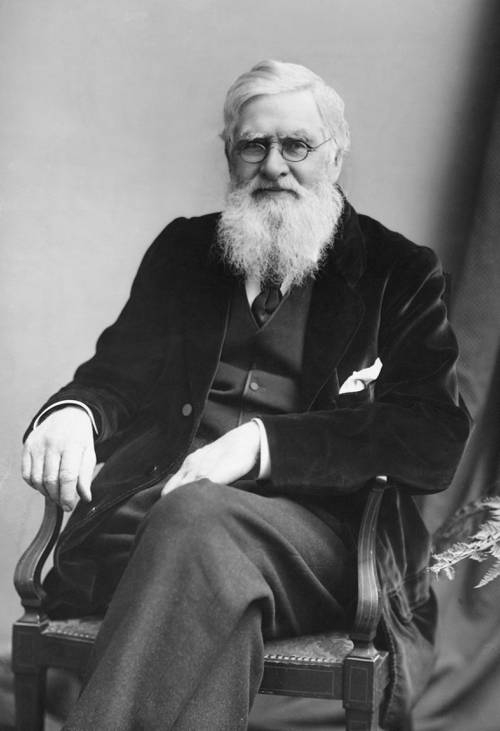
FAQ About Alfred Russel Wallace

Who was Alfred Russel Wallace?
Alfred Russel Wallace was a British naturalist, explorer, geographer, anthropologist, and biologist. He is best known for independently conceiving the theory of evolution through natural selection, which prompted Charles Darwin to publish his own theory on the matter. Wallace's work in the field of biology, primarily his studies of biogeography, made significant contributions to evolutionary biology.

What is Alfred Russel Wallace known for?
Alfred Russel Wallace is famously known for independently developing the theory of evolution through natural selection. His correspondence with Charles Darwin on this theory led to Darwin's publication of "On the Origin of Species." Additionally, Wallace made substantial contributions to biogeography, developing the Wallace Line, which demarcates the distinct ecosystems of Asia and Australia.

How did Alfred Russel Wallace conceive the theory of natural selection?
Alfred Russel Wallace conceived the theory of natural selection during his explorations in the Malay Archipelago. While suffering from a fever in Ternate, he connected his observations of species variation to the idea of survival of the fittest, leading him to formulate his theory on evolution through natural selection. This was outlined in his essay "On the Tendency of Varieties to Depart Indefinitely from the Original Type," which was sent to Darwin in 1858.

What was Alfred Russel Wallace's relationship with Charles Darwin?
Alfred Russel Wallace and Charles Darwin had a professional relationship marked by mutual respect. Wallace's independent formulation of the theory of natural selection prompted Darwin to publish his own work. Upon receiving Wallace's essay, Darwin consulted with other scientists, leading to a joint presentation of their findings to the Linnean Society of London in 1858. Despite offering the same groundbreaking idea, Wallace always admired Darwin and his wider contributions to biology.

What are some of the key works of Alfred Russel Wallace?
Some of Alfred Russel Wallace's key works include "The Malay Archipelago," which is partly an autobiography and partly a book of scientific theory, and "Contributions to the Theory of Natural Selection," which outlines many of his ideas on evolution. His book "The Geographical Distribution of Animals" laid foundational work in the field of biogeography. "Darwinism," published in 1889, is another significant work where Wallace explores and provides evidence supporting the theory of natural selection.

What is the Wallace Line?
The Wallace Line is a faunal boundary line drawn in 1859 by Alfred Russel Wallace that separates the ecozones of Asia and Australia. It delineates a distinct difference in the species found on either side, with Asian species to the west and Australasian species to the east. The existence of such a line highlights the impact of historical geology and evolution in shaping biogeographical patterns.

Did Alfred Russel Wallace write about his explorations?
Yes, Alfred Russel Wallace extensively documented his explorations, most notably in his book "The Malay Archipelago." This work details his observations and collection of specimens during his travels across Southeast Asia and the surrounding islands from 1854 to 1862. It is considered one of the great scientific travel books of the 19th century, providing both personal narrative and scientific inquiry.

How did Alfred Russel Wallace impact the field of biogeography?
Alfred Russel Wallace is often referred to as the "father of biogeography" due to his pioneering studies on species distribution across geographical locations. His observations during his travels in the Amazon River basin and the Malay Archipelago helped him formulate theories about the geographical and ecological factors influencing species evolution and distribution, which became foundational in the study of biogeography.

What was the Ternate essay?
The Ternate essay, formally titled "On the Tendency of Varieties to Depart Indefinitely from the Original Type," was written by Alfred Russel Wallace in 1858. This essay outlined his independently-conceived theory of evolution through natural selection. Wallace sent the essay to Charles Darwin, which subsequently motivated Darwin to present his own findings and to publish "On the Origin of Species."

When did Alfred Russel Wallace live and work?
Alfred Russel Wallace lived from January 8, 1823, to November 7, 1913. His works and explorations were primarily conducted in the mid-to-late 19th century, notably during the 1850s and 1860s, a period of significant scientific discovery and exploration.

Did Alfred Russel Wallace receive recognition for his work during his lifetime?
Yes, Alfred Russel Wallace received considerable recognition and honors during his lifetime. He was a fellow of the Royal Society and was awarded the Royal Society's Royal Medal in 1868 and the Order of Merit in 1908. His work, particularly in biogeography and evolutionary biology, earned him widespread respect and influenced many future scientists.

What was Alfred Russel Wallace's contribution to social and scientific debates?
Beyond his work in biology, Alfred Russel Wallace was an active participant in social and scientific debates of his time. He engaged in discussions on topics such as spiritualism, social equality, land reform, and the rights of animals. Wallace was a critic of the inequities born out of the industrial revolution and advocated for significant social reforms, including socialist principles and a more equitable distribution of land.

How did Alfred Russel Wallace's ideas differ from Charles Darwin's?
While both Wallace and Darwin developed theories of evolution through natural selection, Wallace placed a greater emphasis on environmental pressures in shaping species adaptation. Moreover, Wallace opposed Darwin's views on sexual selection and was more cautious about applying evolutionary theory to human intellectual and moral faculties. Despite these differences, Wallace greatly respected Darwin's broader contributions.

Did Alfred Russel Wallace have any influence on modern science?
Yes, Alfred Russel Wallace has had a lasting influence on modern science, particularly in the fields of evolutionary biology and biogeography. His work laid the groundwork for future ecological and evolutionary studies. Wallace's emphasis on geographical distribution of species continues to provide insights into biodiversity, conservation, and climate change analysis.

What is biogeography and how did Wallace contribute to it?
Biogeography is the study of the distribution of species and ecosystems in geographic space and through geological time. Alfred Russel Wallace's pioneering work in biogeography involved examining species distributions and proposing that they reflect historical and environmental factors. His establishment of the Wallace Line and studies on the geographical distribution of animals created a new understanding of how species evolve and disperse across different landscapes.

Where did Alfred Russel Wallace conduct his notable explorations?
Alfred Russel Wallace conducted his most notable explorations in the Amazon River basin and the Malay Archipelago. These regions are where he collected thousands of specimens, leading to significant scientific discoveries and his formulation of the theory of natural selection.

Did Alfred Russel Wallace write any biographies or autobiographies?
Yes, Alfred Russel Wallace wrote his autobiography titled "My Life," which was published in 1905. The book offers an account of his life, experiences, and scientific explorations, providing readers with personal insights into Wallace's character and the scientific environment of the 19th century.

How did Alfred Russel Wallace view spiritualism and how did it affect his reputation?
Alfred Russel Wallace was a prominent advocate for spiritualism, believing in the potential of spirits to communicate through mediums. His outspoken views led to significant controversy and criticism among the scientific community, which at the time generally dismissed spiritualism as unscientific. Despite this, Wallace continued to support the movement, which affected his reputation but did not significantly overshadow his scientific achievements.

What is the significance of the joint presentation at the Linnean Society in 1858?
The joint presentation at the Linnean Society on July 1, 1858, marked the first formal introduction of the theory of evolution by natural selection to the scientific community. It included readings of papers by both Charles Darwin and Alfred Russel Wallace. Although the event attracted little public attention at the time, it was a critical step in the development and acceptance of evolutionary theory.

What was Alfred Russel Wallace's stance on social issues?
Alfred Russel Wallace was a progressive thinker who often addressed social issues. He was an advocate for social reform and had interests in land nationalization and equality, proposing ideas to improve the welfare of the lower classes. Wallace's writings and beliefs often reflected his sympathy for socialism and criticism of social injustices, which were influenced by the disparities he observed during his scientific explorations.
